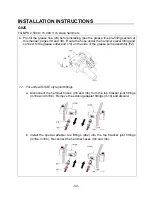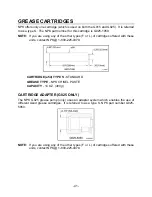
- 40 -
UNDERWATER USE
1. Underwater use is acceptable but caution should be given as not to damage the unit
by striking it blindly below water level.
2. Caution should be given as not to allow water to get into the pump assembly when
changing a grease cartridge.
DO NOT
attempt to change a grease cartridge while
the unit is underwater.
AUTO LUBE TROUBLESHOOTING
If the NPK Auto lube unit is not pumping grease correctly, the following steps may be
taken to diagnose and correct the problem.
PROBLEM CAUSE REMEDY
Eccentric shaft does not
rotate, pump does not
supply lubricant.
No pressure at P oil port of
Auto lube pump assembly.
Check the pressure setting
of the hydraulic circuit.
Filter/Diaphragm assembly
and throttle contaminated.
Clean the filter/diaphragm
and throttle assemblies.
Throttle is closed.
Turn the throttle adjustment
approximately 1-1/2 turns
counterclockwise. Start
hydraulic system, then re-
adjust the throttle to the
proper speed when the unit
is working again.
Hydraulic
motor
faulty.
Replace the hydraulic
motor.
Eccentric shaft rotates,
pump does not supply
lubricant.
Grease cartridge is empty. Replace
cartridge.
Air bubbles in the grease
cartridge.
Unscrew the grease
cartridge from the adapter.
Push the follower piston of
the cartridge by hand until
bubble free lubricant comes
out. Re-install the
cartridge.
DO NOT
overtighten!
Make sure flat seal is not
missing or damaged.
Replace the seals.
The pumping element is
faulty or worn out.
Replace the pumping
element.
Grease comes out of the
discharge opening of the
relief valve.
Grease system back
pressure is too high.
Check the hammer or the
grease line leading to the
hammer for blockage.
Relief valve is faulty.
Replace relief valve.
Grease comes out of the
lateral relief valve hole.
Pumping element is worn
out.
Replace the pumping
element.
















































